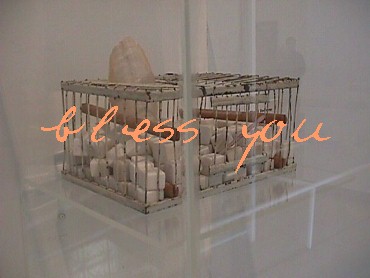
Stephen Lauf, Bless You (digital image with manipulation, 2002.01.06).
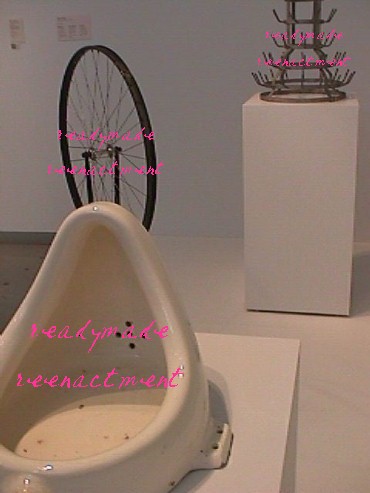
Stephen Lauf, Readymade Reenactment (digital image with manipulation, 2002.01.07).
| |
2002.01.16 17:25
Re: How to be a famous Architect
I followed Gregory Wharton's suggestion and visited www.fat.co.uk/howto.
Upon reflection of this web visit, I was reminded of my first "art exhibition" entitled PROCESS TAKING ITS OWN SHAPE, which was part of Temple University's Architecture Program's Alumni Exhibit 1983. I brought this work together just months after receiving CAD training at INTERGRAPH in Huntsville, Alabama.
You see, CAD is what really got me interested in doing art--there was no more need for me to force my hands with the precision of hand drafting, and my hands and drawing/drafting tools were now free to do with whatever I wanted--because a machine/computer was well taking care of my professional drawing skill.
Process taking its own shape was kind of my answer to "How to become a famous Architect," and actually impressed a lot of the people that originally saw it exhibited.
This exhibit has been 'reenacted' several times, the latest manifestation being a series of webpages within Quondam's 1999 exhibit schizophrenia + architectures.
Given the fact that practically all of my architecture is virtual, it is comforting to remember that art is my reality.
Stephen Lauf
2002.01.19 11:46
Re: lack of life
Sometime in the early 1970s I heard that the first friend of my life went missing, and then a month or so later her body was found in some South Carolina woods near where she and her family had moved to. Janet married quite young (I heard), and also divorced quite young. Her ex-husband was high on the suspect list.
While spending the summer of 1981 in Washington DC, I learned that Jim Williams shot Danny H. and that Jim was accussed of murder. Here I knew (or at least met a few times) both the killed and the killer. You too might know the story by having either read or seen Midnight in the Garden of Good and Evil. In the years after jail in the early 1980s, Jim and I shared the same best friend, and thus I then had a closer than usual but still literally distant friendship with Jim. With all the stuff that I (and very few others) know, why aren't I busy trying to write the next record breaking best-seller? I even have copies of letters that Jim wrote while he was in jail, but somehow "laws of silence" unwittingly prevail. One of Jim's favorite phrases was "You don't know a thing." As far as I know, I'm the only person to have said "You don't know a thing" to Jim in the same way he used to say it to others. Another thing that is not generally known is that one of Jim's strongest motivations was to continually "Piss off the right people."
And then in (I think) 1986 Ismael Faruqi and his wife were brutally murdered in their Philadelphia suburban home. I was good friends with their architect-student neice, and even dated one of their daughters a couple of times (I know we at least saw Saturday Night Fever together). Faruqi was the last Palestinian governor of Galilee, and then head of the Religion Department at Temple University. I only learned of Faruqi's past political postition after his death; I certainly didn't know it the night he drove me home after a late night charette.
"And we become these human jukeboxes spitting out these anecdotes!" -- Six Degrees of Separation
Meanwhile (kind of) Theodosius is still lying in state at Milan, and "he's" going to be there for 38 more days. I have no idea why the laying is state is to take so long except that the total forty days may be some kind of reenactment of the forty days Christ spent in the desert, which is today reenacted annually via Lent. Perhaps this was somehow Ambrose's design, because it is interesting that after forty days, Ambrose should then deliver an obituary within which is the story of how the True Cross was found. [Get it? First Lent and then the Crucifixion.]
So, now that you have a fairly good idea of who Ambrose and Theodosius are, it is time to learn more of Honorius (the younger son of Theodosius who is now Emperor of the West) and his wife Maria. Honorius was the last ancient ruler to [re]build the walls of Rome (because of the "Gothic Wars"--Christian "Goths" that is) and he also built an imperial mausoleum attached to the original Basilica of St. Peter's. Sometime in the 1500s the sarcophagus of Maria was discovered (very likely while the old basilica was being demolished to make way for the new/present one). The sarcophagus of Maria may well be the last remaining substantial imperial artifact of (the city of) Rome, and after an illustrious title page and a frontispiece, it is an image of the sarcophagus of Maria that Piranesi uses to begin his Campo Marzio publication. In a most elegantly covert way, Piranesi began the 'history' of the Campo Marzio with what is really it's ending, and what is probably the world's greatest designed architectural inversionary double theater goes on from there.
Stephen Lauf
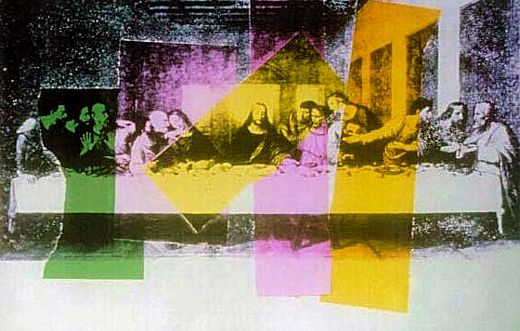
Andy Warhol, The Last Supper (The Dia Center: 1986).
| |
2002.02.01 10:24
no opposition here
I am not opposed to your introduction here of the word/concept appose. Certain definitional phrases in Webster's Third International Dictionary (1969) for appose and apposition provide the solidity of your case:
apply (one thing) to another
deposition of successive layers upon those already present (as in cell walls)
When Nero reenacted the Triumphal Way, he did it with much apposition, probably even controversial apposition (but I doubt anyone opposed). He changed the traditional route, had elephants breaking down part of the city wall, you know, the basic kinds of stuff that Nero is (in)famous for.
The concept of appropriation is very much utilized by artists, and perhaps even more by art historians when they analyze a lot of contemporary art. I don't recall having previously read about the concept of apposition relative to art, and to the activity of artists, till your letters here. As far as I'm concerned, you may have introduced something original, or you may have introduced the concept by actually utilizing the concept itself via your introduction, meaning you may have apposed someone else's prior introduction of the concept of apposition relative to art. In either case, what you write has a refreshing truth to it.
My own artistic oeuvre falls largely within the realm of appropriation, but now I see that much of the same artwork works even better within the realm of apposition. While you may not know it, www.museumpeace.com is named for a truly appositional work of art, viz. a bentwood Gehry chair that I painted over (in 1999) with acrylic and gesso in a slapdash manner. Museumpeace [the rare, one-of-a-kind chair] does not appropriate Gehry, rather it apposes Gehry. For appositional [Lauf] art that you can see now, go to 2000 and choose any of the trophy tattoo links. I uploaded these images as part of "Theatrics Times Two, too" yesterday. Not until I read your last letter this morning, actually not until writing this letter now did I realize the correctly defined nature of these works. Thanks.
Nero made similar breached-wall entries into Naples, Antium, and Albanum on his way to Rome, where he radically rearranged the triumphal route, entering near the Porta Capena and ending at the Temple of Apollo on the Palatine, having also knocked down an arch in the Circus Maximus. Needless to say, this was not a traditional triumph.
Alan Plattus, "Passage into the City: The Interpretive Function of the Roman Triumph" in Ritual (Princeton: The Princeton Architectural Press, 1983) p. 101, note 27.
Returning to Italy, Nero disembarked at Neopolis, where he had made his debut as a singer, and ordered part of the city wall to be razed--which is the Greek custom whenever the victor in any of the Sacred Games comes home. He repeated the same performance at Antium, at Albanum, and finally at Rome. For his processional entry into Rome he Chose the chariot which Augustus had used in his triumph in a former age; and wore a Greek mantle spangled with gold stars over a purple robe. The Olympic wreath was on his head, the Pythian wreath in his right hand, and the others were carried before him, with placards explaining where and against whom he had won them, what songs he had sung, and in what plays he had acted. Nero's chariot was followed by his claque, who behaved like a triumphal escort and shouted that they were they Augustus men celebrating his triumph. The procession passed through the Circus (he had the entrance arch pulled down to allow more room), then by way of the Velabrum and the Forum to the Palatine Hill and the Temple of Apollo. Victims were sacrificed in his honor all along the route, which was sprinkled from time to time with perfume, and the populace showered him with birds, ribbons, and sweetmeats.
Suetonius, "Nero" in The Twelve Caesars (London: Penguin Books, 1979), p. 226.
2002.04.08
Museumpeace apposing Gehry
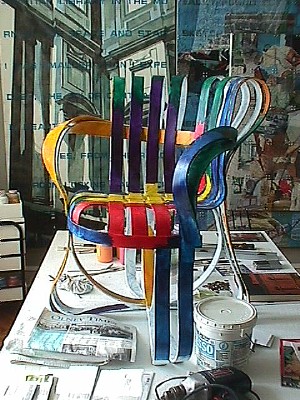 Stephen Lauf, Museumpeace (Philadelphia, 1999)
Stephen Lauf, Museumpeace (Philadelphia, 1999)
|
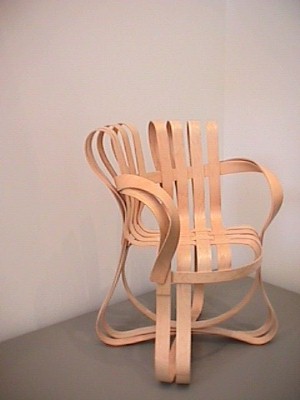 Frank Gehry, Bentwood Chair (on exhibit at the Philadelphia Museum of Art, 2002.03.01)
Frank Gehry, Bentwood Chair (on exhibit at the Philadelphia Museum of Art, 2002.03.01)
|
|